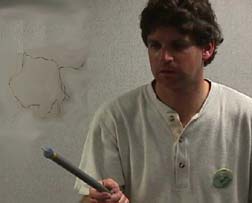Electrostatic levitation

Electrostatic levitation

Introduction
A loop of tinsel can be suspended in the air using electrostatic repulsion by a PVC rod.
Material
Assembly
Tie the tinsel into a loop. It will then be a loop with two legs
sticking out the other side of the knot.
Cut the end of the straw to make a point.
To Do and Notice
Rub the PVC tube with the wool.

You should hear the crackling discharge that indicates that the tube is electrically charged.
Hold the PVC with one end in your hand, hold the loop of tinsel in your other hand, near but not touching the PVC tube, with the two "legs" toward the PVC. Hold it about 10 cm away.
The tinsel will be attracted to the charged PVC. Release the tinsel, it will jump toward the PVC tube.
If the tube is highly charged, notice that the tinsel gets close to the PVC and then jumps away. Watch out! The tinsel will be attracted to your hand and your body, keep away from it! If it touches you it will lose its charge and you will not be able to fly it.
Hold the PVC tube under the tinsel. The electrostatic repulsion will push up the tinsel and hold it in the air even though gravity is pulling it down.
Notice that the loop of tinsel opens up into a circle.
If the tube is less highly charged, the tinsel will be attracted
to and then wrap itself around the tube.
Shake the tinsel loose from the PVC tube or pull it loose using the
soda straw. (Be careful, do not touch the tinsel with your hand. For
students you may want to put two soda straws together to keep them
further away from the tinsel to avoid accidental touches. Slit one
end of a soda straw about 2 cm (1 inch) long. Then push the slit end
of one straw into another.)
If the PVC tube is not charged enough the tinsel will wrap around the PVC. Shake the tinsel loose from the PVC tube, or pull it loose using the soda straw. (Be careful, do not let the tinsel touch your hand, you may want to put two soda straws together to keep your hand farther away from the tinsel. Slit one end of a soda straw about 2 cm (1 inch) long. Then push the slit end of one straw into another.)
If the PVC is too weakly charged the tinsel will stick to the PVC, then when you pull it off the PVC it will not fly. It will not open up into a circle either. In this case rub the PVC with wool harder and longer.
What's Going On?
When you rub the PVC with the wool it becomes negatively charged. (You can check this using the tape electroscope.)
The tinsel is attracted to the charged PVC since charged things attract uncharged things by electrically polarizing them. That is, the near side of the tinsel becomes positively charged while the far side becomes negative. The attraction of the negative PVC for the near, positive, side of the tinsel is weaker than the repulsion for the far, negative, side.
When the tinsel gets close enough to the PVC, some of the charge from the PVC is transferred to the tinsel so that both are negatively charged. They then repel and you can use this repulsion to fly the tinsel.
The tinsel opens up into a circle since all of the negative charges on the conducting aluminum of the tinsel repel each other.
If the rod is not charged enough then the negative charge on the insulating rod cannot jump to the tinsel which remains mostly uncharged. The negatively charged tinsel then attracts and holds the uncharged tinsel. When you pull the tinsel off using the straw it should pop open to form a circle, if it does not, it is not charged enough to be levitated.
The tinsel opens up into a circle since all of the negative charges on the conducting aluminum of the tinsel repel each other. They spread uniformly around the tinsel then push each other away to form a circle.
Etc.
If you can get some of the thin flat pink plastic that Asian markets use to wrap packages you can make, and then fly, a "hydra." See the Snack, Flying Hydra.
Tidbit
You can also use a large piece of Styrofoam, over 30 cm square (1 foot) to fly the tinsel and the hydra.
Resources
See the book "Flying Tinsel" by Grant Mellor, June 1993, Addison Wesley
|
Scientific Explorations with Paul Doherty |
|
19 Mar 99 |